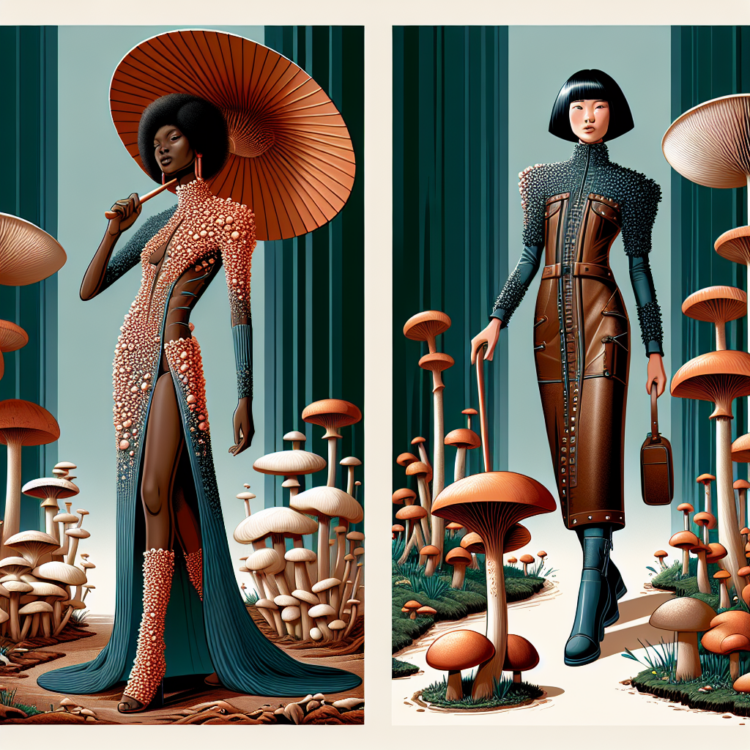As fashion designers look for alternatives to leather, growing mycelium – or fungi-based – ‘leather’ substitutes using a new paste media has opened up the possibility of growing this bio-fabricated material faster, and of cultivating it more easily.
As fashion designers look for alternatives to leather, growing mycelium – or fungi-based – ‘leather’ substitutes using a new paste media has opened up the possibility of growing this bio-fabricated material faster, and of cultivating it more easily.
Researchers investigating how to grow and cultivate mycelium leather more effectively tested their hypotheses by growing and harvesting mycelium leather mats using a new paste of their own design as a substrate. Their findings are published in the Cambridge University Press journal Research Directions: Biotechnology Design.
Mycelium materials offer a low-cost and environmentally sustainable alternative to some petroleum-based materials and a more sustainable and ethical alternative to animal-derived leather. They can be grown on a wide variety of agricultural and industrial organic waste or side streams.
With greater uptake and scaling of production, these products have the potential to become more economically viable than established traditional materials. They can also be optimised to meet consumer demands.
The researchers examined mushroom compatibility for the purposes of leather mat development by using two fungal species: Ganoderma lucidum (reishi), a medicinal mushroom widely used within bio-design; and Pleurotus djamor (pink oyster), a gourmet mushroom that has the tendency to quickly colonise the substrate and enter the fruiting stage – meaning it produces mushroom fruit bodies fast.
By carefully formulating a new paste substrate for the mushrooms to grow in, the researchers sought to enhance nutrient availability from the mushrooms; enable their scalability; and streamline their cultivation processes.
Different species of mushrooms have their own preferences for substrates, meaning that an important part of growing mushrooms – and mycelium leather – involves matching one’s mushrooms with the best available substrate. Common substrates include straw, coffee grounds, and manure.
Mycelium leather is produced by growing the fungus as a biological tissue or mat on top of a liquid or solid substrate, or as fungal biomass in submerged liquid fermentation. Solid-state fermentation offers superior growth conditions; however, liquid-state surface fermentation allows mycelium mats to be harvested more easily, although growth rates are slower due to lower oxygen levels. Lastly, liquid-state fermentation gives improved yields, yet the product must be further manipulated to produce a mycelium mat.
As a response to these challenges, the researchers developed a new method for cultivation based on a paste consistency substrate that offers the benefits of high nutrient content as well as small nutrient particle size, aiding the uptake of nutrients.
The researchers found that by using this particular paste, they were able to grow thicker mycelial mats over a shorter period of time in comparison to growth on nutrient-enriched agar or liquid culture. Moreover, further benefits of this growth method became apparent during the harvesting stage, as the mats had grown strong enough that it was possible to peel them without needing to cut the sheet.
Lead author of the study Assia Crawford, of the University of Colorado in the United States, said:
“As our world searches for sustainable alternatives to traditional materials, there has been growing interest in using living organisms to produce biodegradable material substitutes with low environmental impact – such as mycelium leather, which is an eco-friendly leather alternative.
“The extensive treatment needed to transform hide into traditional leather comes with high environmental costs, Moreover, petrochemical alternatives like faux leather, which have become increasingly popular in response to the challenges of animal leather production and associated ethical concerns, also have significant environmental impacts associated with the extraction of fossil fuels, long degradation spans, and potential off-gassing risks. Developing better alternatives is crucial in today’s environmentally fragile world.
“Bio-design methods like the ones explored in our study contribute to developing high-quality, scalable, biodegradable material alternatives. These in turn have the potential to address the environmental challenges of high textile consumption. Indeed, the flexible nature of pure mycelial mats is a compelling potential substitute for non-woven materials such as animal-derived leather and petroleum-based faux leather alternatives. As researchers, we have a responsibility to continue developing better materials in response to the climate crisis, which is what the study aims to do.”
Journal
Research Directions Biotechnology Design
Method of Research
Experimental study
Subject of Research
Not applicable
Article Title
From fungi to fashion: mushroom eco-leather is moving towards the mainstream
Article Publication Date
23-Apr-2024




